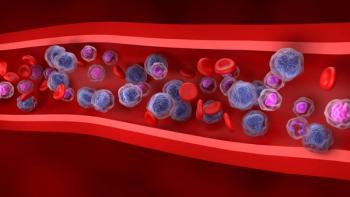
Front-Line Immunotherapy Improves Survival in Kidney Cancer Subtype, Versus Certain Targeted Therapies
Patients with metastatic non–clear cell renal cell carcinoma who receive immune checkpoint inhibitor–based regimens as a first treatment option may have improved survival, versus those who receive select targeted therapies.
Immune checkpoint inhibitor–based regimens administered as a first treatment option in patients with metastatic non–clear cell renal cell carcinoma (RCC) may be associated with improved overall survival, versus select targeted therapies.
Results of a retrospective analysis presented during the 2021 American Society of Clinical Oncology Genitourinary Cancers Symposium demonstrated that among 1,181 patients with metastatic RCC, the median overall survival (OS) in those who received an immune checkpoint inhibitor–based regimen was 28.6 months versus 19.2 months with a vascular endothelial growth factor (VEGF) inhibitor and 12.6 months with an mTOR inhibitor.
The objective response rate (the proportion of patients who had a complete or partial response to treatment) among those who received an immunotherapy-based treatment regimen was 25%. Patients who received a VEGF targeted therapy achieved an objective response rate of 17.8% and those in the mTOR-targeted treatment arm reached an objective response rate of 5.8%.
Moreover, the median time-to-treatment failure in those who received an immunotherapy-based regimen was also longer at 6.9 months versus 5.1 months with a VEGF inhibitor and 3.9 months with a mechanistic target of rapamycin (mTOR) inhibitor.
“Immune checkpoint inhibitor–based front-line therapy appears to be associated with improved OS compared to VEGF and mTOR targeted therapy in treatment-naive metastatic non–clear cell RCC, even after adjustment for International Metastatic RCC Database Consortium [IMDC] risk, histology, and age,” lead study author Dr. Jeffrey Graham, of the University of Manitoba in Canada, and colleagues, wrote in a poster on the data.
Immunotherapy options have induced impressive activity in patients with metastatic clear-cell RCC; as such, these options have become part of standard front-line treatment. Although non–clear cell RCC represents about 15% of all kidney cancers, findings supporting the efficacy of immune checkpoint inhibitors as an initial treatment option have remained largely limited.
To address this need, investigators launched a study to detail the real-world effectiveness of front-line approaches containing immune checkpoint inhibitors in patients with metastatic non–clear cell RCC.
To perform a retrospective analysis of an international database, investigators included all patients who had non–clear cell histology. Patients were categorized into three groups based on first-line treatment: single-agent VEGF therapy, single-agent or combination immunotherapy, and single-agent mTOR therapy.
The median age of the entire patient population was 60.6 years, 65.4% were male, 76.4% had undergone nephrectomy, and 16.6% had sarcomatoid features. The most common histologic subtype across the groups was papillary disease (54.2%), and most patients fell into an intermediate risk group (55.1%). Across the groups, 25.1% of patients had liver metastases, 34.2% had bone metastases, and 3.6% had brain metastases.
Of the 1,181 patients included in the analysis, 924 had received VEGF treatment, which included Sutent (sunitinib, 68.4%), Votrient (pazopanib, 18.5%), Nexavar (sorafenib, 7.8%), Cabometyx (cabozantinib, 1.3%), or other (4%). Moreover, 186 patients had received mTOR inhibitors in the front-line setting, such as Torisel (temsirolimus, 75.8%) or Afinitor (everolimus, 24.2%).
The remaining 65 patients had received immune checkpoint inhibitor–based therapy, which could include Opdivo (nivolumab) and Yervoy (ipilimumab, 30.8%), Tecentriq (atezolizumab) plus Avastin (bevacizumab, 21.5%), Opdivo (20%), Keytruda (pembrolizumab, 20%), or other (7.7%).
When looking at objective response rate per histologic subgroup, those with papillary disease who received VEGF treatment experienced an objective response rate of 13% versus 3.7% with mTOR therapy and 31.6% with immunotherapy-based treatment. In patients with the chromophobe subtype, the objective response rates were 20.6% versus 13.6% versus 9.1% in those who received VEGF therapy, mTOR therapy, and an immunotherapy-based regimen, respectively. Those with an unclassified disease subtype experienced objective response rate of 15.2%, 0%, and 33.3%, respectively.
“The (objective response rate) of 25% in the entire population is consistent with the existing literature of immune checkpoint inhibitor therapy in non–clear cell RCC, with lower responses seen in the chromophobe subgroup and higher responses seen in the papillary subgroup,” the study authors wrote. “The study population was predominantly papillary RCC, and the effectiveness of immune checkpoint inhibitor–based therapy in other less common histologic subtypes remains inconclusive.”
The results yielded from the analysis must be confirmed in prospective, randomized clinical trials, the authors concluded.
For more news on cancer updates, research and education, don’t forget to





